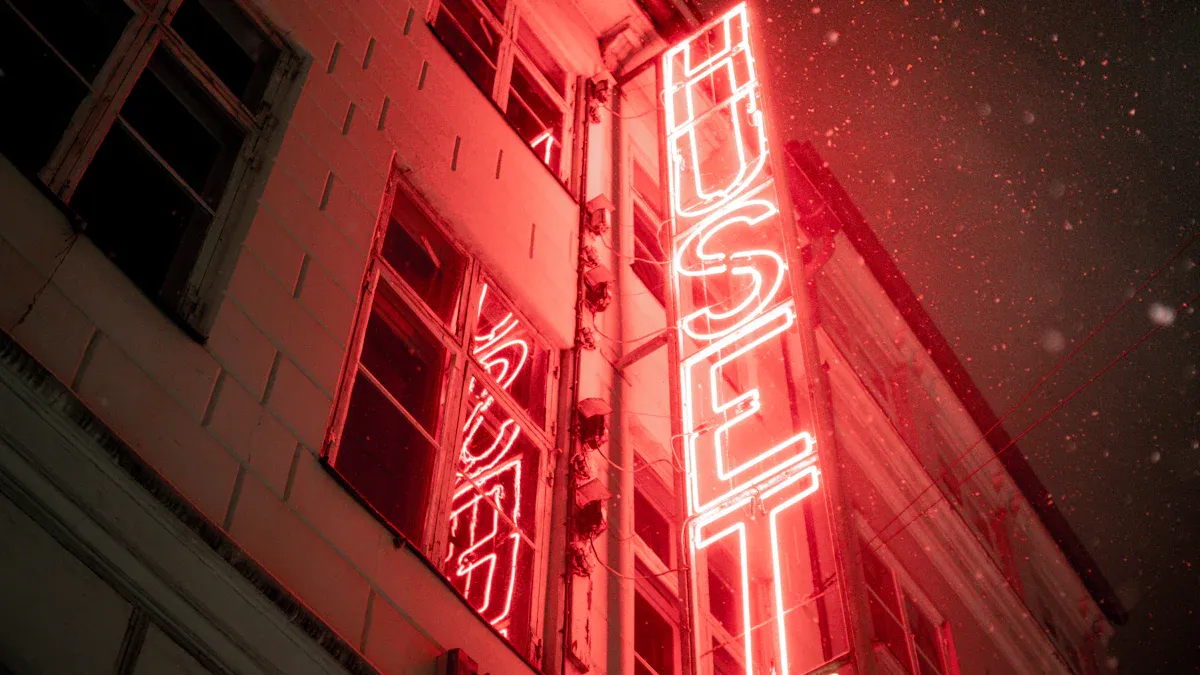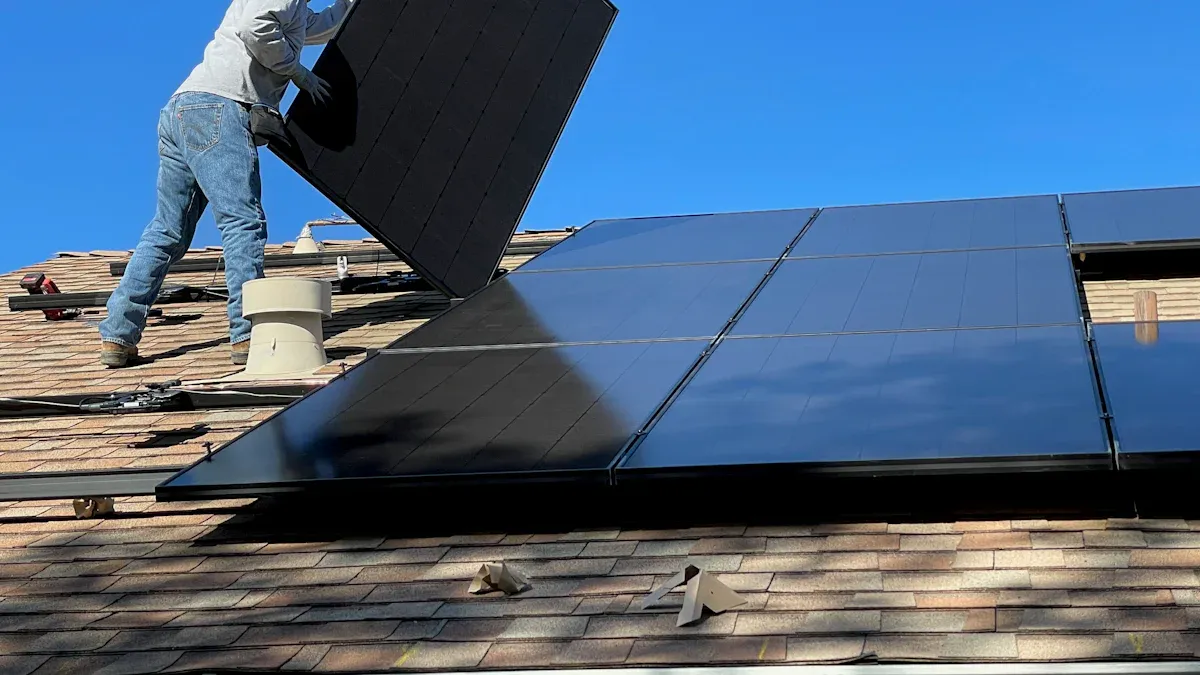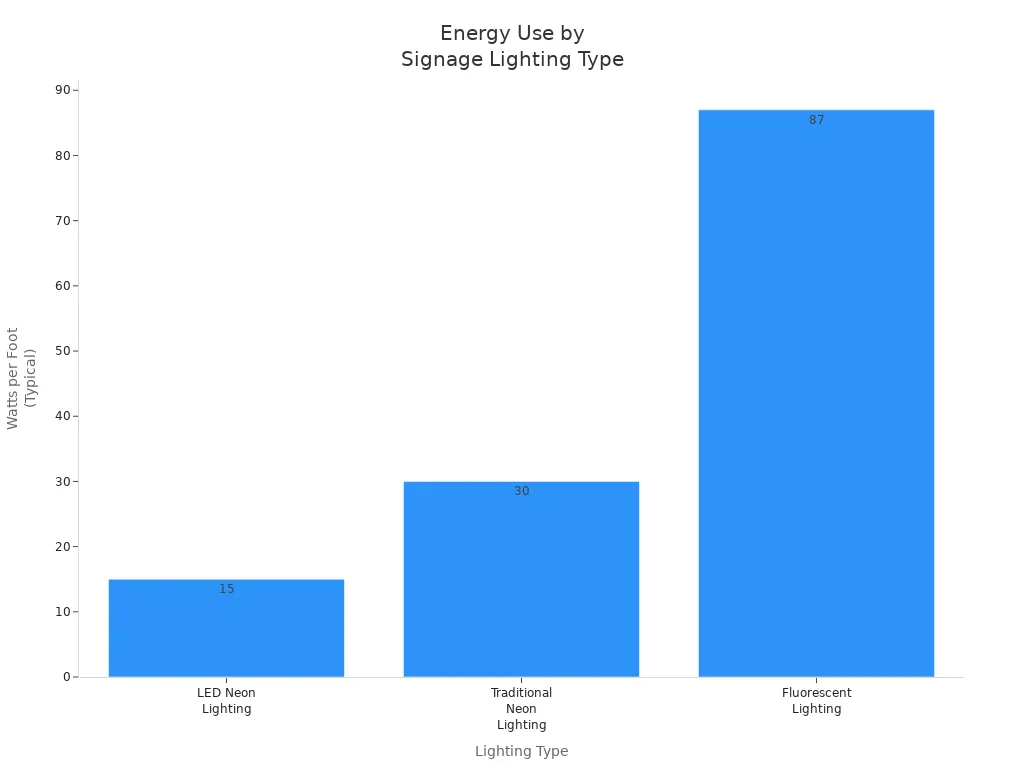Choose LED Lighting for Signs: Brightness, Color, and Installation Tips

When you choose led lighting for your sign, you shape how people see your business. Brightness, color, and installation all play a big role in catching attention and saving money. According to Tupp Signs, 85% of small business owners say switching to illuminated signage boosted their brand’s local visibility within three months.
Using led light options helps you:
Lower your energy bills and carbon footprint.
Get rebates or tax breaks in some areas.
Reduce heat, which keeps your Product looking fresh.
Take time to match your led lighting and installation to your signage needs and brand style.
Key Takeaways
Pick LED lighting to use less energy and need less fixing. It also helps people see your sign better all day and night. Match the LED brightness and color to your sign’s size and where it is. Make sure the colors fit your brand. This helps your sign look clear and bright. Use the right way to mount, waterproof, and wire your LED signs. This keeps them safe and helps them last longer. Look at LED specs like lumen output, color temperature, and CRI. This makes sure your sign is bright and the colors look real. Clean and check your LED signs often. This keeps them bright and working well.
Choose LED Lighting
Key Factors
When you choose led lighting for your signs, you set the stage for how your business looks day and night. The right signage lighting led can make your sign pop, save you money, and last for years. You want to look at several factors to consider when choosing signage lighting led. Start with energy efficiency. Energy-efficient illumination means lower bills and less impact on the planet. LED signs use less power than old-school lights, so you get more brightness with less waste.
Think about longevity and reliability. LED strip lights and led neon sign options last much longer than traditional bulbs. That means fewer replacements and less hassle. You also want to check the warranty and certifications. Look for UL or DLC marks on the Lighting Facts Label. These show your signage lighting led meets safety and quality standards.
Color is another big deal. The best led signs match your brand colors and keep them looking sharp. Some types of signage lighting leds let you change colors or dim the lights for different moods. This flexibility helps your signage stand out in any setting. When you choose led lighting, you also get the benefits of signage lighting leds like design freedom and programmable displays. That’s a win for any business.
Sign Size and Depth
The size and depth of your sign matter a lot when you choose led lighting. Deep sign cabinets let you space out your led strip lights more, which can save you money and avoid hot spots. For shallow signs, you need closer spacing and sometimes special modules to keep the brightness even. If you use a led neon sign in a thin cabinet, pick modules with wide beam angles for smooth lighting.
Here’s a quick look at how cabinet depth affects your choices:
Cabinet Depth | LED Module Type | Spacing | Best For |
|---|---|---|---|
1/2" to 4" | Low-profile, wide beam | Close spacing | Shallow led signs |
Over 5" | High-output modules | Wider spacing | Deep led neon sign |
Always match the illuminated color to your sign graphics for brand consistency. Check the Lighting Facts Label for lumen output and color temperature. This helps you get the right brightness and color every time. When you choose led lighting, you get signage lighting solutions that fit any sign, from small indoor led neon sign displays to large outdoor led signs. The benefits include energy-efficient, long-lasting, and reliable lighting that keeps your signage looking great.
LED Brightness

Measuring Brightness
When you choose led sign lights for your signs, you want to know how bright they will be. Lumens measure the total visible light from your lighting, not just the power used. This means you get a true idea of how much brightness your led signs will deliver. Unlike old bulbs, led lighting focuses light right where you need it, so your sign stands out with high visibility.
Take a look at this table to see how led lighting compares to traditional bulbs:
Lighting Technology | Lumens per Watt | Brightness Implication |
|---|---|---|
At least 120 | More visible light per watt, higher brightness efficiency | |
Incandescent Bulbs | 12-24 | Lower light output per watt, less efficient brightness |
You can see that led sign lights produce 5 to 10 times more light per watt than old bulbs. Most of the power in incandescent lights turns into heat, not brightness. Led signs use energy to make light, not heat, so your signage gets better brightness and clarity. Modern led lighting labels show lumen output, not just watts, because lumens tell you how much light your signs will actually show.
Tip: Always check the lumen rating on your led sign lights. Higher lumens mean better visibility and more impact for your signs.
Recommended Levels
You want your signs to have high visibility, whether they are indoors or outdoors. The right brightness depends on where you install your signage and what kind of lighting surrounds it. For outdoor led signs, you need more brightness to compete with sunlight. Indoor led signs need less brightness because the lighting is controlled.
Here’s a quick guide for recommended brightness levels:
Application Scenario | Recommended Brightness (nits) |
|---|---|
Indoor (conference rooms) | 200–500 |
Indoor video playback | 400–800 |
Outdoor facing direct sunlight | 7,000–10,000 |
Outdoor in shaded areas | 5,000–6,000 |
Indoor led signs usually need between 500 and 1,000 nits. Outdoor led signs need much higher brightness, sometimes up to 10,000 nits, to stay visible in daylight. If your sign faces direct sunlight, aim for at least 7,000 nits. In shaded outdoor spots, 5,000 nits will work. This keeps your signage lighting bright and clear, so people notice your sign.
Note: Adjust the brightness of your led sign lights to match the environment. Too much brightness indoors can cause eye strain, while too little outdoors can make your signs hard to see.
The Impact of Color on Brightness and Visibility
Color affects how bright your led signs look. The human eye sees green led lighting as brighter than red or blue at the same power. Even if your led sign lights have the same lumen rating, green will seem brighter. Blue led lights often look dimmer, so you may need more brightness for high visibility. Beam angle also matters. A narrow beam makes your signage lighting look brighter in one spot, while a wide beam spreads the light out.
If you use pure red, green, or blue led sign lights at high brightness, the colors can look harsh or unnatural. Mixing colors or adding white led lighting helps your signs look comfortable and natural. Always match the color of your led signs to your graphics and branding for the best brightness and clarity.
Checking CRI for Accurate Color Appearance
Color Rendering Index (CRI) tells you how well your led lighting shows true colors. CRI goes from 0 to 100. Led sign lights with a CRI above 90 make colors look vibrant and natural. This is important for signage lighting in retail, galleries, or anywhere you want your signs to pop. Lower CRI values make colors look dull or faded, which hurts brightness and clarity.
CRI 95-100: Best for art galleries and high-end retail signs.
CRI 90-95: Great for led signs in most business settings.
CRI 80-90: Good for general signage lighting, but colors are less vivid.
Below 80: Not recommended for led signs where color matters.
Tip: Choose led sign lights with a CRI above 90 for high visibility and accurate color. Your signage will look sharp and attract more attention.
When you focus on brightness, color, and CRI, your led signs will deliver the brightness and clarity you need. Your signage lighting will stand out, save energy, and show your brand at its best.
Color in Signage Lighting
Color Temperature
When you pick led neon sign lighting, you need to think about color temperature. This means how warm or cool the lights look, measured in Kelvins (K). Warm lights (around 2800K-3500K) give off a soft, yellow glow. These lights make reds and oranges pop, which works well for cozy places. Cool lights (5000K-6500K) shine with a bluish-white tone. These lights boost blues and greens, making your led neon sign look crisp and modern.
Most commercial led signs use color temperatures between 3500K and 6500K. If you want your led neon sign to stand out in a busy area, try 5000K for a natural white look. For outdoor led neon sign displays, 6000K can help with visibility at night. Picking the right color temperature helps your sign graphics look their best. If you go too warm or too cool, colors can shift and lose their punch. You want your led neon sign to show true colors and grab attention.
Tip: Test your led neon sign under different lights before you install it. This helps you see how color temperature changes the look.
Color Rendering
Color rendering is all about how well your led neon sign shows colors. The Color Rendering Index (CRI) tells you how true and vibrant colors appear under your lights. High CRI (above 90) means your led neon sign will show colors that look natural and bright. This is important for led signs in stores, galleries, or anywhere you want people to notice your brand.
Here’s why high CRI matters for your led neon sign:
Colors look vivid and match your graphics.
Your led neon sign stands out and boosts visibility.
People feel comfortable looking at your lights.
Your brand colors stay consistent day and night.
Vibrant led colors like red, green, and blue make your led neon sign pop. Bright led lights attract customers and help your business get noticed. Nearly 76% of people say they walked into a store because of its sign. When you match your led neon sign colors to your graphics and the environment, you create a strong brand image. Use high contrast and test your led neon sign in real conditions. This way, your led neon sign will always look sharp and inviting.
Install Signage Lighting LEDs

Putting up signage lighting can look hard at first. You can make it easy by following simple steps. If you learn how to install signage lighting leds, your signs will look bright and last longer. Let’s go over the steps for mounting, wiring, and keeping your signage lighting safe.
Mounting and Placement
Begin with a plan for your sign. Measure the area so you get the right led strip lights. Silicone tubing bends to fit custom shapes. Put the led strip lights inside the tubing. Use clips or glue to hold them in place. This keeps the lighting even and stops it from moving.
If your sign is taller than five feet, be careful with mounting. Point the led strip lights toward the sign face. This gives a soft glow and stops harsh reflections. Space the led strip lights evenly for smooth brightness. For big signs, use longer standoffs to spread the light. This helps hide shadows. Try to put hardware in the middle of the sign. This stops light from getting blocked. If you see shadows, add more led strip lights until it looks right.
Test your sign lighting from far away, like 25 feet in the dark. This helps you find uneven spots or reflections. Use grid or even patterns for placing led strip lights. This gives good coverage and fewer dark spots. Near the edges, put led strip lights closer together or use brighter modules for even light.
Tip: Use reflectors and diffusers to spread light and stop glare. Pick fixture shapes that fit your sign, like straight, round, or adjustable.
Wiring and Connectors
Wiring is very important for your signage lighting. Use push-in wire connectors for quick and strong connections. For outdoor signs, use waterproof wire connectors to stop water damage. Twist-on, winged, and crimp-on connectors work for different wires. Always match connector size to your wire to stop overheating.
Solderless connectors make led strip lights easy to install. Snap-on or stab-in connectors work for single color, RGB, or RGBW led strip lights. Make sure the connector fits your strip width—5mm, 8mm, 10mm, or 12mm. For outdoor lighting, use waterproof connectors with IP65 or higher. Straight connectors make strips longer. L-shaped connectors fit corners. T- or X-shaped connectors help with branching.
Follow the maker’s rules for wiring and use the right tools. Hide wires to keep them safe and make your sign look neat. Check connections often for damage or heat problems. Good wiring keeps your signage lighting safe and working well.
Outdoor Considerations
Outdoor signs face rain, wind, and changing temperatures. Protect your led strip lights with waterproofing. Here’s a quick guide:
Waterproof Method Type | IP Rating | Waterproofing Technique | Suitable Outdoor Conditions and Use Cases |
|---|---|---|---|
Silicone Coating | IP65 | Surface silicone coating | Light rain, splash-proof, patios, under eaves |
Silicone Tube Strip | IP65 | Inserted into silicone tube | Contour lighting, easy replacement |
Neon Tube Sleeved Strip | IP65 | Sealed inside flexible neon tube | Even light diffusion, decorative signage |
Hollow Extrusion Strip | IP67 | Silicone extrusion with sealed ends | Heavy rain, garden edges, reusable housing |
Silicone Filling Strip | IP68 | Fully filled with silicone gel | Underwater use, fountains, ponds |
Silicone Extrusion Strip | IP68 | Extrusion plus silicone filling | Harsh environments, highest durability |
Pick the right mounting for outdoor signs. Clip mounting holds led strip lights on rough surfaces. Recessed mounting hides strips for a clean look. Aluminum channels add strength and help with heat. Suspension mounting works for hanging signs. Double-sided tape is fast but not strong outdoors.
Check the IP rating for your signage lighting. IP65 protects against water jets and light rain. IP67 works for heavy rain and short dips in water. IP68 is best for underwater or always-wet places. Choose the rating that fits your weather.
Note: Always seal the ends of your led strip lights and connectors. This keeps water out and your signage lighting working all year.
Dimming and Controls
Dimmers make your signage lighting flexible. You can change brightness and color temperature for your brand or mood. Dimmers lower heat and save energy, so led strip lights last longer. Many dimmers have remote controls and smart features for easy changes.
Dimming helps your signs stand out at night without being too bright. You get smooth light and can show special deals or events. Lower brightness saves money and keeps your signage lighting cool.
Safety, Maintenance, and Energy Efficiency
Safety is most important when installing. Use certified led strip lights and parts that meet UL standards. Hire skilled installers for big signs to keep things safe. Think about wind, lightning, and weight for outdoor signs. Plan for easy cleaning and repairs later.
Regular care keeps your signage lighting bright and working well. Clean led strip lights to remove dirt. Check wires and connectors for damage. Replace bad bulbs fast to keep lighting even. Look for moisture, rust, and overheating. Do yearly checks and update software if your sign is smart.
Led strip lights save lots of energy. They use up to 80% less power than fluorescent or neon lights and last much longer. See this chart:

Feature | LED Lighting | Fluorescent Lighting | Neon Lighting |
|---|---|---|---|
Uses 75% less energy than fluorescents; less than neon lights | Higher energy use | Consumes 20-40 watts per foot, more than LED neon flex | |
Brightness & Visibility | Brighter, more vibrant, visible even in daylight | Less bright | Traditional neon less bright than LED neon flex |
Heat Generation | Generates very little heat | Generates more heat | Generates more heat |
Lifespan | Up to 100,000 hours | 7,000-15,000 hours | About 30,000 hours |
Maintenance | Requires less maintenance | More frequent replacements | Risk of gas leakage and dimming |
Environmental Impact | Mercury-free, lower voltage, eco-friendly | Contains mercury, higher voltage | Contains neon gas, fragile |
Design & Weight | Lightweight, thin, flexible designs | Bulkier than LED | Thick, heavy glass tubes |
You save money on bills and repairs. Your signage lighting stays bright and good for the planet. Led strip lights also let you change colors and add animation.
Callout: Don’t make mistakes like using the wrong hardware, skipping waterproofing, or making bad electrical connections. Always use the right mounting, waterproof seals, and certified electricians for your signage lighting.
If you follow these steps and tips, your signage lighting will look great, last longer, and save you money. You get all the good things from led strip lights—energy savings, strength, and bright displays—while keeping your signs safe and easy to care for.
Choosing LED lighting for your signs means thinking about brightness, color, and how you install everything. You want LEDs that fit your sign’s size, location, and weather conditions. Always check specs like IP rating, voltage, and color accuracy. Use a checklist to plan your project, test equipment, and review safety steps. If your sign project feels complex, reach out to a lighting consultant. They help you pick the right products and make sure your sign looks great and works safely.
FAQ
How do I know which LED brightness is right for my sign?
Check the lumen rating on the LED package. For outdoor signs, pick higher lumens for better visibility. For indoor signs, use lower lumens to avoid glare. Test your sign at night and during the day to see what looks best.
Can I install LED sign lighting myself?
You can install simple LED strips if you follow the instructions. For large or outdoor signs, hire a professional. This keeps your sign safe and working well. Always turn off the power before you start.
How often do I need to maintain my LED sign lights?
LEDs last a long time, but you should check them every few months. Clean the lights and look for damage or loose wires. Replace any broken parts right away. Regular care keeps your sign bright and safe.
What color temperature should I choose for my business sign?
Pick a color temperature that matches your brand. Warm white (around 3000K) feels cozy. Cool white (5000K–6500K) looks modern and bright. Test different options to see which one fits your style and stands out.
See Also
Selecting The Ideal Lighting Sign System For Your Needs
Complete Guide To Creating Effective LED Outdoor Signage
Advantages, Varieties, And Installation Tips For LED Exterior Lighting
Key Features And Benefits Of GE LED Light Bulbs Explained
Choosing The Best LED Lighting For Display Cases Effectively

